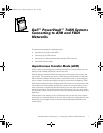
Dell PowerVault 7x0N Systems — Connecting to ATM and FDDI Networks 1
!
This document discusses the following topics:
Asynchronous transfer mode (ATM)
Connecting to an ATM network
Connecting to a fiber distributed data interface (FDDI) network
Command reference guide
ATM is a network technology that combines the features of cell-switching and multi-
plexing to offer reliable and efficient network services.
ATM provides an interface between devices such as workstations and routers, and
the network. The asynchronous nature of ATM means that bandwidth is made avail-
able on demand instead of allocating slots of transmission time to network devices,
as is the case in a synchronous system employing time-division multiplexing (TDM).
ATM employs fixed-sized cells of 53 bytes each as the basic unit of transmission. Each
cell consists of a 5-octet header, identifying the source of the transmission, among
other information, and a 48-octet payload containing the user data and headers for
higher-level protocols. This architecture permits data ranging from text, voice, graph-
ics, and video to share the same network without any one source dominating network
bandwidth.
ATM employs a star topology with an ATM switch acting as the hub of the network.
All devices are connected directly to this hub, making network configuration and trou-
bleshooting more straightforward, as well as offering dedicated bandwidth to the
central switch.
65CNPbk0.book Page 1 Monday, September 13, 1999 1:43 PM


















